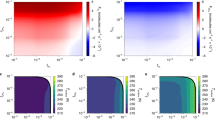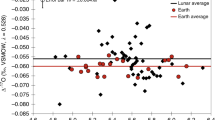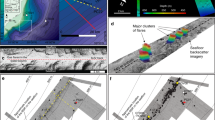Abstract
Observations from NASA’s Cassini spacecraft established that Saturn’s moon Enceladus has an internal liquid ocean. Analysis of a plume of ocean material ejected into space suggests that alkaline hydrothermal vents are present on Enceladus’s seafloor. On Earth, such deep-sea vents harbour microbial ecosystems rich in methanogenic archaea. Here we use a Bayesian statistical approach to quantify the probability that methanogenesis (biotic methane production) might explain the escape rates of molecular hydrogen and methane in Enceladus’s plume, as measured by Cassini instruments. We find that the observed escape rates (1) cannot be explained solely by the abiotic alteration of the rocky core by serpentinization; (2) are compatible with the hypothesis of habitable conditions for methanogens; and (3) score the highest likelihood under the hypothesis of methanogenesis, assuming that the probability of life emerging is high enough. If the probability of life emerging on Enceladus is low, the Cassini measurements are consistent with habitable yet uninhabited hydrothermal vents and point to unknown sources of methane (for example, primordial methane) awaiting discovery by future missions.
This is a preview of subscription content, access via your institution
Access options
Access Nature and 54 other Nature Portfolio journals
Get Nature+, our best-value online-access subscription
$29.99 / 30 days
cancel any time
Subscribe to this journal
Receive 12 digital issues and online access to articles
$119.00 per year
only $9.92 per issue
Buy this article
- Purchase on Springer Link
- Instant access to full article PDF
Prices may be subject to local taxes which are calculated during checkout



Similar content being viewed by others
Data availability
Simulated datasets from which the figures were generated are available at https://gitlab.com/antonin.affholder/enceladus_bayesian_methanogenesis.
Code availability
The code of the model presented in the article is available at https://gitlab.com/antonin.affholder/enceladus_bayesian_methanogenesis.
References
Spilker, L. Cassini-Huygens’ exploration of the Saturn system: 13 years of discovery. Science 364, 1046–1051 (2019).
Thomas, P. et al. Enceladus’s measured physical libration requires a global subsurface ocean. Icarus 264, 37–47 (2016).
Waite, J. H. et al. Cassini finds molecular hydrogen in the Enceladus plume: evidence for hydrothermal processes. Science 356, 155–159 (2017).
Nathues, A. et al. Recent cryovolcanic activity at Occator crater on Ceres. Nat. Astron. 4, 794–801 (2020).
Schmidt, B. et al. Post-impact cryo-hydrologic formation of small mounds and hills in Ceres’s Occator crater. Nat. Geosci. 13, 605–610 (2020).
Reynolds, R. T., Squyres, S. W., Colburn, D. S. & McKay, C. P. On the habitability of Europa. Icarus 56, 246–254 (1983).
Martin, A. & McMinn, A. Sea ice, extremophiles and life on extra-terrestrial ocean worlds. Int. J. Astrobiol. 17, 1–16 (2018).
McCollom, T. M. Methanogenesis as a potential source of chemical energy for primary biomass production by autotrophic organisms in hydrothermal systems on Europa. J. Geophys. Res. Planets 104, 30729–30742 (1999).
Hsu, H.-W. et al. Ongoing hydrothermal activities within Enceladus. Nature 519, 207–210 (2015).
Glein, C. R., Baross, J. A. & Waite, J. H. Jr The pH of Enceladus’ ocean. Geochim. Cosmochim. Acta 162, 202–219 (2015).
Choblet, G. et al. Powering prolonged hydrothermal activity inside Enceladus. Nat. Astron. 1, 841–847 (2017).
Kleerebezem, R. & Van Loosdrecht, M. C. A generalized method for thermodynamic state analysis of environmental systems. Crit. Rev. Environ. Sci. Technol. 40, 1–54 (2010).
Mousis, O. et al. Formation conditions of Enceladus and origin of its methane reservoir. Astrophys. J. Lett. 701, L39 (2009).
McKay, C., Khare, B. N., Amin, R., Klasson, M. & Kral, T. A. Possible sources for methane and C2–C5 organics in the plume of Enceladus. Planet. Space Sci. 71, 73–79 (2012).
Jannasch, H. W. & Mottl, M. J. Geomicrobiology of deep-sea hydrothermal vents. Science 229, 717–725 (1985).
Schrenk, M. O., Kelley, D. S., Bolton, S. A. & Baross, J. A. Low archaeal diversity linked to subseafloor geochemical processes at the Lost City Hydrothermal Field, Mid-Atlantic Ridge. Environ. Microbiol. 6, 1086–1095 (2004).
Hedderich, R. & Whitman, W. B. in The Prokaryotes: Prokaryotic Physiology and Biochemistry (eds Rosenberg, E. et al.) 635–662 (Springer, 2013).
Travis, B. & Schubert, G. Keeping Enceladus warm. Icarus 250, 32–42 (2015).
Martin, W., Baross, J., Kelley, D. & Russell, M. J. Hydrothermal vents and the origin of life. Nat. Rev. Microbiol. 6, 805–814 (2008).
Taubner, R.-S. et al. Biological methane production under putative Enceladus-like conditions. Nat. Commun. 9, 748 (2018).
McKay, C. P., Porco, C. C., Altheide, T., Davis, W. L. & Kral, T. A. The possible origin and persistence of life on Enceladus and detection of biomarkers in the plume. Astrobiology 8, 909–919 (2008).
Catling, D. C. et al. Exoplanet biosignatures: a framework for their assessment. Astrobiology 18, 709–738 (2018).
Lorenz, R. D. A. Bayesian approach to biosignature detection on ocean worlds. Nat. Astron. 3, 466–467 (2019).
Bouquet, A., Mousis, O., Waite, J. H. & Picaud, S. Possible evidence for a methane source in Enceladus’ ocean. Geophys. Res. Lett. 42, 1334–1339 (2015).
Neveu, M. & Rhoden, A. R. Evolution of Saturn’s mid-sized moons. Nat. Astron. 3, 543–552 (2019).
Prialnik, D. & Merk, R. Growth and evolution of small porous icy bodies with an adaptive-grid thermal evolution code: I. Application to Kuiper belt objects and Enceladus. Icarus 197, 211–220 (2008).
Roberts, J. H. The fluffy core of Enceladus. Icarus 258, 54–66 (2015).
Goodman, J. C., Collins, G. C., Marshall, J. & Pierrehumbert, R. T. Hydrothermal plume dynamics on Europa: implications for chaos formation. J. Geophys. Res. Planets 109, E03008 (2004).
Goodman, J. C. & Lenferink, E. Numerical simulations of marine hydrothermal plumes for Europa and other icy worlds. Icarus 221, 970–983 (2012).
Topçuoğlu, B. D. et al. Hydrogen limitation and syntrophic growth among natural assemblages of thermophilic methanogens at deep-sea hydrothermal vents. Front. Microbiol. 7, 1240 (2016).
Daniel, R. M. et al. The molecular basis of the effect of temperature on enzyme activity. Biochem. J. 425, 353–360 (2010).
Tijhuis, L., Van Loosdrecht, M. C. & Heijnen, J. A thermodynamically based correlation for maintenance Gibbs energy requirements in aerobic and anaerobic chemotrophic growth. Biotechnol. Bioeng. 42, 509–519 (1993).
Sleep, N., Meibom, A., Fridriksson, T., Coleman, R. & Bird, D. H2-rich fluids from serpentinization: geochemical and biotic implications. Proc. Natl. Acad. Sci. USA 101, 12818–12823 (2004).
McCollom, T. M. Abiotic methane formation during experimental serpentinization of olivine. Proc. Natl Acad. Sci. USA 113, 13965–13970 (2016).
Pudlo, P. et al. Reliable ABC model choice via random forests. Bioinformatics 32, 859–866 (2015).
Krissansen-Totton, J., Olson, S. & Catling, D. C. Disequilibrium biosignatures over Earth history and implications for detecting exoplanet life. Sci. Adv. 4, eaao5747 (2018).
Russell, M. J. et al. The drive to life on wet and icy worlds. Astrobiology 14, 308–343 (2014).
Sasselov, D. D., Grotzinger, J. P. & Sutherland, J. D. The origin of life as a planetary phenomenon. Sci. Adv. 6, eaax3419 (2020).
Takai, K. et al. Cell proliferation at 122°C and isotopically heavy CH4 production by a hyperthermophilic methanogen under high-pressure cultivation. Proc. Natl Acad. Sci. USA 105, 10949–10954 (2008).
Kalirai, J. Scientific discovery with the James Webb Space Telescope. Contemp. Phys. 59, 251–290 (2018).
Phillips, C. B. & Pappalardo, R. T. Europa Clipper mission concept: exploring Jupiter’s ocean moon. Eos 95, 165–167 (2014).
Eigenbrode, J., Gold, R. E., McKay, C. P., Hurford, T. & Davila, A. Searching for life in an ocean world: the Enceladus Life Signatures and Habitability (ELSAH) mission concept. In Proc. 42nd COSPAR Scientific Assembly abstr. F3.6–3-18 (2018).
Cable, M. L. et al. Enceladus Life Finder: The Search for Life in a Habitable Moon (NASA, JPL, 2016); https://trs.jpl.nasa.gov/handle/2014/45905
Mitri, G. et al. Explorer of Enceladus and Titan (E2T): investigating ocean worlds’ evolution and habitability in the solar system. Planet. Space Sci. 155, 73–90 (2018).
Sauterey, B., Charnay, B., Affholder, A., Mazevet, S. & Ferrière, R. Co-evolution of primitive methane-cycling ecosystems and early Earth’s atmosphere and climate. Nat. Commun. 11, 2705 (2020).
Lever, M. A. et al. Life under extreme energy limitation: a synthesis of laboratory-and field-based investigations. FEMS Microbiol. Rev. 39, 688–728 (2015).
Connolly, J. P. & Coffin, R. B. Model of carbon cycling in planktonic food webs. J. Environ. Eng. 121, 682–690 (1995).
Krissansen-Totton, J. & Catling, D. C. Constraining climate sensitivity and continental versus seafloor weathering using an inverse geological carbon cycle model. Nat. Commun. 8, 15423 (2017).
Virtanen, P. et al. SciPy 1.0: fundamental algorithms for scientific computing in Python. Nat. Methods 17, 261–272 (2020).
Gillooly, J. F., Brown, J. H., West, G. B., Savage, V. M. & Charnov, E. L. Effects of size and temperature on metabolic rate. Science 293, 2248–2251 (2001).
Csilléry, K., Blum, M. G., Gaggiotti, O. E. & François, O. Approximate Bayesian computation (ABC) in practice. Trends Ecol. Evol. 25, 410–418 (2010).
Sisson, S. A., Fan, Y. & Beaumont, M. Handbook of Approximate Bayesian Computation (Chapman and Hall/CRC, 2018).
Pedregosa, F. et al. Scikit-learn: machine learning in Python. J. Mach. Learn. Res. 12, 2825–2830 (2011).
Tutolo, B. M., Seyfried, W. E. & Tosca, N. J. A seawater throttle on H2 production in Precambrian serpentinizing systems. Proc. Natl Acad. Sci. USA 117, 14756–14763 (2020).
Glein, C. R. & Waite, J. H. The carbonate geochemistry of Enceladus’ ocean. Geophys. Res. Lett. 47, e2019GL085885 (2020).
Charlou, J., Donval, J., Fouquet, Y., Jean-Baptiste, P. & Holm, N. Geochemistry of high H2 and CH4 vent fluids issuing from ultramafic rocks at the Rainbow hydrothermal field (36°14’ N, MAR). Chem. Geol. 191, 345–359 (2002).
Acknowledgements
We are grateful for discussion with D. Apai, A. Bixel, B. Charnay, Z. Grochau-Wright, B. Kacar, J. Kasting, C. Lineweaver, V. Thouzeau and members of the OCAV Project at PSL University and of NASA’s Nexus for Exoplanet System Science (NExSS) research coordination network and its Earths in Other Solar Systems Project based at the University of Arizona. This work is supported by France Investissements d’Avenir programme (grant numbers ANR-10-LABX-54 MemoLife and ANR-10-IDEX-0001-02 PSL) through PSL IRIS OCAV and PSL–University of Arizona Mobility Program. R.F. acknowledges support from the US National Science Foundation, Dimensions of Biodiversity (DEB-1831493), Biology Integration Institute-Implementation (DBI-2022070) and National Research Traineeship (DGE-2022055) programmes; and from the United States National Aeronautics and Space Administration, Interdisciplinary Consortium for Astrobiology Research programme (grant number 80NSSC21K059).
Author information
Authors and Affiliations
Contributions
R.F., F.G. and S.M. conceived the study. R.F. designed the ecosystem model. F.G. and S.M. designed the geochemical model. A.A. and B.S. refined the models and developed the code. A.A. analysed the results and wrote the first version of the manuscript. All authors finalized the paper.
Corresponding authors
Ethics declarations
Competing interests
The authors declare no competing interests.
Additional information
Peer review information Nature Astronomy thanks David Catling, Ruth-Sophie Taubner and the other, anonymous, reviewer(s) for their contribution to the peer review of this work.
Publisher’s note Springer Nature remains neutral with regard to jurisdictional claims in published maps and institutional affiliations.
Extended data
Extended Data Fig. 1 Overview of the Bayesian inference framework as a two-directional probability tree.
x0 is an observation of system outputs, coming from the Cassini mission: \({\Phi }_{{{\rm{H}}}_{2}}\) the flux of dihydrogen, \({\Phi }_{{{\rm{CH}}}_{4}}\) the flux of methane, and the ratio H2:CH4. θ denotes the set of internal parameters, namely the composition of Enceladus’ putative hydrothermal fluid and ocean as well as hydrothermal fluid temperature. The modelling workflow reads from right to left: the model evaluates ‘habitability’ (H) from a set of parameters and produces so-called pseudo-data x when biological activity (B) contributes to shaping sea-floor waters composition (or not, A, ‘abiotic’); x and θ are thus related through x=π(θ), where π denotes a model. The inference workflow reads from left to right: the goal is to determine the posterior probability P(B∣x0), which requires to compute likelihoods (for example, P(x0∣B)), see Methods.
Extended Data Fig. 2 Biological and chemical default parameter values as well as physical and chemical constants.
Description and standard values of all parameters in the model, with references from which they are taken where applicable. All figures were produced using these parameter values.
Extended Data Fig. 3 Summary of prior distributions.
For details on the boundaries described here, see Methods.
Extended Data Fig. 4 Model outputs across the prior ranges of internal parameters.
a, Outputs of the purely abiotic model. Blue dots denote uninhabitable simulations, orange dots denote habitable simulations. b, Outputs of the model including biological activity. Green dots denote habitable simulations in which biological methanogenesis occurs. Escape rates of methane and dihydrogen (\({\Phi }_{{{\rm{CH}}}_{4}}\) and \({\Phi }_{{{\rm{H}}}_{2}}\) respectively) are given in mol yr−1 while H2:CH4 has no dimension. All concentrations are given in mol kg-1and temperature is given in Kelvin. Note the log10 scale for every variable but the temperature. Magenta dashed lines indicate the observed values of each observable. See Methods for model equations, Extended Data Table 1 for internal parameter ranges, and Extended Data Table 2 for parameters values.
Extended Data Fig. 5 Likelihood of the Cassini observations: H2 escape rate (\({\Phi }_{{{\rm{H}}}_{2}}\), mol yr−1), CH4 escape rate (\({\Phi }_{{{\rm{CH}}}_{4}}\), mol yr−1), and H2:CH4 ratio under models predicting ‘uninhabitability’, ‘abiotic-habitability’, and ‘biotic’ methane production.
a, c, Likelihood of the observables for the different models when serpentinization is the only modeled abiotic source of methane, for P(B∣H) =0.5 (a) and P(B∣H) =0.05 (c). b,d, Likelihood of the observables for the different models when the abiotic methane concentration in the hydrothermal may be much higher, for P(B∣H) =0.5 (b) and P(B∣H) =0.05 (d). Blue bars denote the likelihood of the \(\overline{H}\) model (‘uninhabitable’), orange bars denote the likelihood of the Hab model (‘abiotic-habitable’) and green bars denote the likelihood of B (‘biotic’). Likelihood values are obtained by integrating the kernel density estimate approximation of the simulated samples (forexampleFig. 2a,d,f) in the observation interval. The bars are labeled ‘ ≈ 0’ when the likelihood was found to be <10−4. Internal parameters range are explained in Methods and given in Extended Data Table 1, model parameters are given in Extended Data Table 2.
Extended Data Fig. 6 Abiotic and biotic methane production with an increased upper bound on [CH4]f.
a, Outputs of the purely abiotic model. Blue dots indicate ‘uninhabitable’ simulations (\(\overline{H}\)), orange dots indicate ‘abiotic-habitable’ simulations (Hab). b, Outputs of the model including biological activity. Green dots indicate habitable simulations in which biological methanogenesis occurs (B). Magenta dashed lines: Cassini observations. Black dashed lines point to minimum values of CH4 concentration in the HF to explain the lower and upper bounds of observed \({\Phi }_{{{\rm{CH}}}_{4}}\). Internal parameters ranges are explained in Methods and Extended Data Table 1, model parameters are given in Extended Data Table 2.
Extended Data Fig. 7 Cassini observations and distributions of model outputs over the space of observables when higher abiotic methane concentration in the HF is allowed.
a, d, f Univariate distributions for each observable. b, c, e Joint distributions. The color code separates the pseudo-data into simulations that were uninhabitable (\(\overline{H}\), blue), abiotic-habitable (Hab, orange), and biotic (B, green). Magenta dashed lines and stars indicate the observed values of each observable. See Fig. 2 for more details, Methods for model equations, and Extended Data Tables 1 and 2 for definitions of plotted parameters, prior internal parameter ranges, and model parameters.
Extended Data Fig. 8 Parameters of the ABC inference.
Description and values for the parameters of the Approximate Bayesian Computation Random Forest procedure done with the Python Sickit-learn package53.
Supplementary information
Supplementary Information
Supplementary Figs. 1–6, Methods, Results and Discussion.
Rights and permissions
About this article
Cite this article
Affholder, A., Guyot, F., Sauterey, B. et al. Bayesian analysis of Enceladus’s plume data to assess methanogenesis. Nat Astron 5, 805–814 (2021). https://doi.org/10.1038/s41550-021-01372-6
Received:
Accepted:
Published:
Issue Date:
DOI: https://doi.org/10.1038/s41550-021-01372-6
This article is cited by
-
Sustained and comparative habitability beyond Earth
Nature Astronomy (2023)
-
Detection of HCN and diverse redox chemistry in the plume of Enceladus
Nature Astronomy (2023)
-
Medical Astro-Microbiology: Current Role and Future Challenges
Journal of the Indian Institute of Science (2023)
-
Investigating Europa’s Habitability with the Europa Clipper
Space Science Reviews (2023)
-
Survival strategies of an anoxic microbial ecosystem in Lake Untersee, a potential analog for Enceladus
Scientific Reports (2022)



